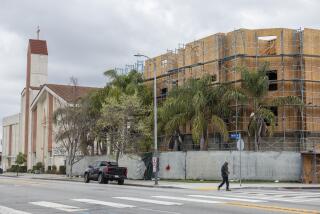Here’s how California’s new plan to cap rent increases would work
SACRAMENTO — California lawmakers are on the verge of approving one of the only state laws in the nation to limit rent increases after Gov. Gavin Newsom announced a deal with legislative leaders last week on a bill to cap annual rent hikes.
The measure, Assembly Bill 1482, would limit yearly rent increases statewide to 5% plus inflation for the next decade. Experts believe the measure would provide more stability for renters while also potentially leading to more regular rent hikes for tenants. Powerful interest groups have lined up against the measure, and its passage by the Legislature’s Sept. 13 deadline is far from assured.
What would the bill do?
Supporters of the measure have pitched it as a way to prevent sudden increases in rents at levels that could drive people from their homes as the state experiences a surge in housing costs.
“It’s critical that this passes to address the plight of millions of tenants during the worst housing crisis in our state’s history,” said the bill’s author, Assemblyman David Chiu (D-San Francisco).
The bill also limits the ability of landlords to evict tenants without documented lease violations after a renter has lived in an apartment for a year. If a landlord wants to convert a building to condominiums or make substantial renovations to units, they could evict tenants but would have to pay relocation assistance equal to one month’s rent.
Apartments built in the last 15 years would be exempt from the cap. So would single-family home rentals unless they’re owned by corporations or other institutional investors, such as Invitation Homes, which has about 12,000 single-family home rentals in the state.
The legislation would not override existing rent control rules in Los Angeles, San Francisco, Oakland and other cities that have them or want to adopt them. However, the new bill would expand the number of properties subject to some restriction on rent increases in those cities.
Under state law, Los Angeles is prohibited from extending rent control to apartments built after October 1978; most cities are barred from implementing controls on units built after 1995. UC Berkeley’s Terner Center for Housing Innovation analyzed the potential effect of the legislation in Los Angeles’ Boyle Heights neighborhood, the Mission District in San Francisco and Fruitvale in Oakland and found an additional 23,400 apartments would fall under the rent cap in each of those neighborhoods.
According to the Terner Center, the rent cap would apply to 2.4 million apartments statewide in addition to single-family home rentals that meet the bill’s requirements.
How would it affect renters, landlords and the housing market?
Earlier this year, the Terner Center examined 10 communities in different areas of the state — San Francisco, Oakland, Fresno, Los Angeles, Long Beach, West Sacramento, San Rafael, Stockton, Chula Vista and Vallejo — and found a majority of recent rent increases would be allowed under the cap.
But some areas did see major surges in rents. In Boyle Heights, apartments without rent controls saw rents increase from a median $1,200 a month to $1,700 between 2016 and 2017. Such rent hikes would no longer be allowed under the legislation.
“This really is an anti-gouging cap and that is its effect,” said Elizabeth Kneebone, the Terner Center’s research director. “It would not affect the majority of rent increases.”
Still, the bill could have consequences beyond extending protections for renters. Brian Asquith, an economist with the Michigan-based Upjohn Institute, said landlords who might have held rents for existing tenants at below-market rates with the knowledge they could increase them at any time might decide to hike rents every year.
“If you talk to people on the ground there’s almost universal consensus this occurs,” said Asquith, who has studied California’s rent regulations.
Asquith also pointed to research that says restrictions on rent hikes encourage owners to convert their apartments into condominiums, which removes properties from rental stock. He expects that could happen in wealthy suburban communities that don’t have rent restrictions.
“I think the people who are going to be hurt are upwardly mobile, striving families who are middle-income or lower-income in Irvine, who can’t afford to buy a house but where renting might be in their reach,” he said.
Housing production in California is slowing, exacerbating the state’s shortage of available homes. The California Assn. of Realtors, an influential organization opposed to the bill, has argued that the rent cap would further stifle production by discouraging apartment owners from building.
But the California Building Industry Assn., which represents home builders, said in a letter to Chiu this week that the bill’s exclusion of apartments built within the last 15 years made the organization “optimistic that this approach will not create an impediment to new construction.”
How does the bill compare to other efforts around the U.S.?
If the Legislature passes AB 1482, California would become the third state to approve a significant expansion of limits on rent hikes this year. Oregon lawmakers passed a statewide rent cap of 7% plus inflation, while New York state legislators beefed up existing rent restrictions in New York City and also allowed other cities to stabilize rents. California’s plan would be stricter than Oregon’s, although the rent cap here would expire in a decade while Oregon’s is permanent. Elements of New York’s rules, including limitations on the ability of landlords to increase rents when tenants move out, are stronger than AB 1482.
The Los Angeles-based AIDS Healthcare Foundation is collecting signatures for a rent control initiative that would appear on the November 2020 statewide ballot. That measure is more stringent than AB 1482 and would limit the ability of landlords to raise rents when a new tenant moves in. Unlike the statewide rent cap, if the initiative were to pass, the resulting rent control rules would only apply in cities and counties that approved them.
What are the bill’s chances of becoming law?
AB 1482 has taken a long and strange path through the Legislature. Last fall, California voters decisively rejected an initiative that would have allowed for the expansion of local rent control policies across the state. Newsom opposed the initiative and upon taking office called on lawmakers to pass alternative renter protection measures.
Chiu introduced AB 1482 at the behest of pro-tenant groups, but weakened it in the face of opposition from landlords, Realtors and others. It squeaked through the Assembly in May.
Early last month, Newsom decided to get more involved. He told reporters that he wanted a tighter cap than what was then in the bill.
“I was surprised,” Chiu said. “Pleasantly surprised.”
The governor’s advisors then began deeper negotiations. Fearing the bill might pass without its input, the California Apartment Assn., which represents landlords, decided to work toward a deal, said Deb Carlton, the association’s senior vice president. The organization secured changes, including loosening proposed anti-eviction rules, and no longer opposes the bill.
But the new version of AB 1482 includes a stricter rent cap for a longer time frame than what the Realtors had previously agreed to. Less than two hours after Newsom announced the rent cap deal, the Realtors announced their renewed opposition.
The margin for passage is thin. In May, the weaker version of the rent cap cleared the Assembly by three votes, with 18 Democrats voting no or abstaining.
More to Read
Sign up for Essential California
The most important California stories and recommendations in your inbox every morning.
You may occasionally receive promotional content from the Los Angeles Times.











